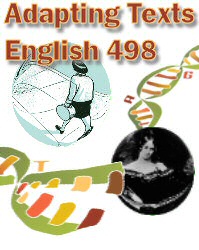 |
 |
 |
 |
|
Sample Star Wars Case StudyStar Wars is a rare species of text that achieved (and continues to achieve) a hulking commercial popularity while at the same time spawning and nurturing a rabid and devoted cult following. In her article on adaptation theory, Joy Gould Boyum notes the feeling of uncertainty amongst a group of people prior to viewing a film adaptation of a book, due largely in part to the “private set of expectations” (Boyum 43) that each person had. In the Star Wars universe, the millions of viewers of the original film were faced with that feeling of uncertain anticipation two times in the short period after the release of the first film: prior to The Empire Strikes Back and Return of the Jedi. Star Wars, a science fiction/action/adventure/romance/coming-of-age story, and a wildly popular one at that, clearly must have instilled a certain set of private expectations for each of the throngs of people that lined up to see the sequel films. The awareness of, and harnessing of these expectations engendered the genre of spin-off literature to be discussed here. The existence and style of execution of this literature, exemplified here by Steve Perry’s Shadows of the Empire, is a widespread implementation of the feelings inspired by a text and the tensions in adaptation of them discussed by Boyum and a literal manifestation of the desires and expectations that a reader has for an adaptation of a source text. Perry’s novel is the story of a tense power triangle between the established characters of Darth Vader and Luke Skywalker, dueling father and son Jedi Knights, and a newly invented character named Prince Xizor, a high ranking figure in the Empire as well as the leader of a massively wealthy and powerful crime syndicate known as Black Sun. Xizor and Vader are competing for rank and power within the Empire, and Luke Skywalker is the pawn used by each of them to curry favor with Emperor Palpatine. Though this is the main power struggle in the story, much of the narrative focuses on incidental galactic adventures had by Luke and his traveling companions—Leia, Chewbacca, Lando Calrissian, the Droids, and another new creation of Steve Perry named Dash Rendar. The story takes place in between the cinematic timelines of The Empire Strikes Back and Return of the Jedi, which in itself is quite indicative of the adaptive process here. The story, at its outset, continually references the lingering consequences of the conclusion of The Empire Strikes Back and proceeds with the presumption that the reader will know most of the pre-existing interrelations of the cinema saga. It begins with a pre-existing set of characters and circumstances and then extends the narrative to invent new adventures and further explore the personalities of the characters. As Boyum states, our experience of intake for film is “intensely personal and nostalgic” (Boyum 48) and our expectations for an extension of this personal experience “depend on considerable prior psychological and even cognitive activity.” (Boyum 49). Our wariness of adaptations hinges on an intrusion upon our very personal ownership of the experience of a reading of the source text. Steve Perry, who I can only assume was first a fan of Star Wars before he was an extension novelist, has seized the opportunity to modify the adaptation to suit all of his desires and apprehensions circling a reworking of the Star Wars world and characters. Perry and scores of other adaptors, whether sanctioned by Lucasfilm or not, have circumvented the very trepidation which is the wellspring of Boyum’s argument. Whatever they wanted more or less emphasis of in the parameters drawn by George Lucas, they created accordingly. These authors, being admirers of the films, wrote from the same personal experiences that (judging from the box-office receipts) were most likely at least somewhat universally shared by the same fan base that would be the target audience for the books. Although she is discussing the inverse adaptation of books into films, Boyum’s phrase on the experience of reader response says it most effectively: “In a sense, we do make our own movies” (Boyum 50). Boyum categorizes film’s language as highly conventionalized (Boyum 46), and the widespread acceptance of the conventions employed by Star Wars allowed for the vast popularity to grow. Perry, by the same token, attempts to recreate the narrative experience and universal appeal through the use of conventions in his text. For example, the editing wipes and introductory text in the film reference 1950s comic books and television science fiction series. Very similarly, Perry’s novel offers its narrative in a very episodic manner, with short passages of action broken into many different segments even within the short chapters. The action is fast-paced and many of the segments end on lucrative cliffhangers. Also, Lucas’ film presents scenes in isolated spheres of knowledge. From our first glimpse of Princess Leia encoding secret messages to planning in the Imperial War Rooms to covert deals made in the Mos Eisley Cantina, the characters operate intentionally apart from one another. Perry’s short segments all contain a third-person narrator. However, this narrator switches perspectives between the episodes, and the reader is only allowed into the internal thoughts of one character. Although Perry certainly creates his own plot and explores characters in ways that Lucas the writer did not, his mirroring through prose the cinematic conventions employed by Lucas the director recreates, in a way, the same immersing world of adventure and science fiction that made the Star Wars film so immediately likable. They also exemplify a manifestation of Perry’s personal experience in watching the film, an experience he hopes to capitalize on by recreating it for his reading audience. Ultimately, the phenomenon of these extension novels solves the problem that plagues Joy Boyum throughout her argument, and through a usually academically-scorned genre, the Star Wars extension novelists like Steve Perry have seen an avenue of adaptation that the well-cultured and erudite Boyum did not. A person with a possessive experience of a source text is difficult to satisfy with any sort of adaptation, no matter how intrepid or accurate. An adventurous, contrarian approach to a source text can disappoint because it does not ally itself with the viewer’s preexisting experience, and a supremely faithful adaptation can also fall inferior because it is only a come-lately facsimile of the already effective and memorable experience. And as with all adaptation theory, fidelity is a central issue, either in the discontent for lack of it or through the failure to create a compelling, self-standing work because of insistence upon it. In Perry’s novel, and those like it, fidelity is not at issue. The Gospel according to George Lucas has already been written and committed to film, and there is little that can be done by these adaptors to sully that. In Perry’s case, it also saves him work as a writer, for he can omit visual descriptions and behavioral characterizations of the well-known characters. In a way, extension novels like this almost are written to be intentionally subservient to the exalted source film. Perry doesn’t attempt the grand, sweeping narrative present in the films. While his story is engaging and a thrill-ride, he omits much of the overarching story regarding Luke’s journey to become a Jedi Knight and the tension that exists because of his concealed family past. It is almost as if Perry leaves that for the films, because he is not worthy to contribute such a weighty addition to the character arcs. Just as Perry’s novel picks up where The Empire Strikes Back left off, it must also set up the entire galaxy—character positions, grudges, battle consequences, etc—for the beginning of Return of the Jedi. Like a bowling alley pinsetter, Perry must leave the Star Wars universe ultimately unaltered and ready for use in the next film, a characteristic that is indicative of the extension novel phenomenon as a whole. The level of freedom taken with the adaptation is limited by the reverence for the source text, which is the reason these adaptations are made in the first place. Works CitedBoyum, Joy Gould. “The Viewer as Reader: Varieties of Interpretation.” Double Exposure: Fiction Into Film. New York: Universe Books, 1985. 43-62. Perry, Steve. Star Wars: Shadows of the Empire. New York: Bantam/Spectra, 1997. Star Wars. Director/Writer George Lucas. Videodisc. Lucasfilm, 2001. Copyright 2006 Charlie Stadtlander. Last Update: 6/21/06
|